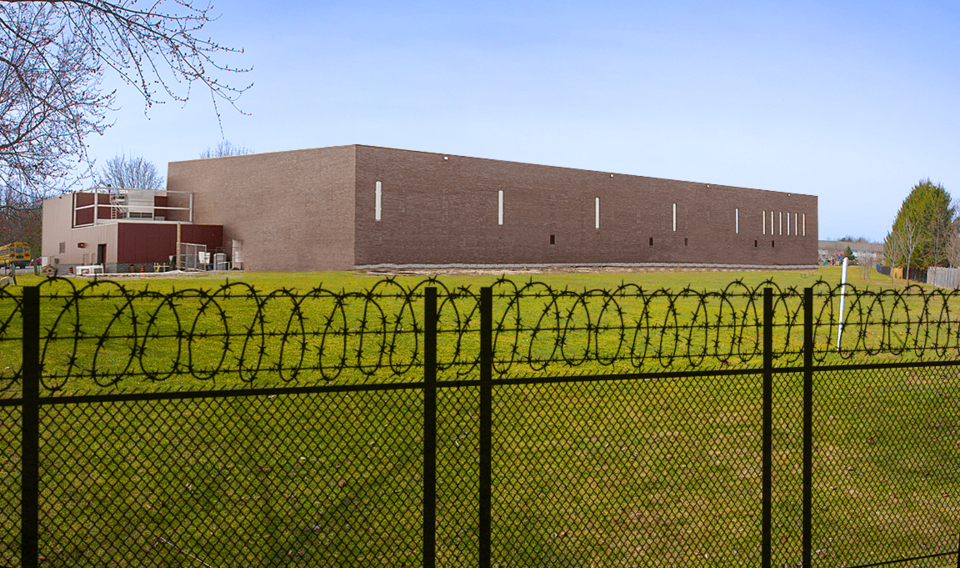PELHAM, Ontario, April 1 — At a hastily arranged press conference held in Council chambers on Saturday, the Town of Pelham revealed plans to demolish the current Pelham Arena on Haist Street and replace it with a minimum security prison.
The Town will build the facility itself, acting as developer.
“We’ve had such outstanding success negotiating great deals in East Fonthill,” said Pelham CAO Darren Ottaway, “this decision a no-brainer.”
“Literally,” said Mayor Dave Augustyn.
For several months, the Town had touted a plan to sell the property to private developers, who would build medium and high-density housing. This plan is now abandoned.
Ottaway and the Mayor jointly removed a cloth draped over an illustration of the proposed penal facility.
“In the end, you have to ask yourself,” said Ottaway, “does more housing actually generate wealth? Of what value are ordinary residents, anyway? Where is the wealth?”
Mayor Augustyn, breaking into a wide smile, nodded in agreement. At this, the rest of Council, also present for the announcement, followed suit, heads bobbing in unison.
Ottaway pointed at the illustration.
“This, right here, is wealth-creation. By building and running our own prison, the Town will earn revenue from every inmate.”
“And needless to say,” said the Mayor, “this prison will feature the most vibrant, innovative, and caring rehabilitation program in Niagara. ‘Hashtag PelhamPrisonWow!' 'Hashtag RegionalChairHereICome!’”
Minimum security correctional facilities—often nicknamed “country club” prisons—typically house inmates sentenced for white collar crimes and low-level drug offences. White collar crimes are defined as non-violent, financially motivated offences committed by business and government officials, such as bribery, embezzlement, and fraud.
“Not only that,” continued Augustyn, “we have a vibrant, innovative, and caring way to pay for it.”
“No more debentures through the Region,” said Ottaway.
“Definitely not,” said Augustyn. “Way too much red ink—uh, red tape.”
Augustyn called on Treasurer Teresa Quinlin, who had a presentation board of her own. Headlined, “How We Say We Pay For It,” it featured a series of progressively smaller dollar signs moving from a wide base at the bottom to a narrow peak at the top.
“We’re saving money two ways,” said Quinlin. “First, there’s no need to hire an architect and start from scratch. We already have our design. We’re adapting the new community centre—"
“’Meridian’ Community Centre,” interjected Augustyn.
“Right, we’re adapting the Meridian Community Centre design,” continued Quinlin. “Its handsome, windowless walls of brick—"
“American brick,” interjected Ottaway.
“Right, American brick,” continued Quinlin, “Its massive windowless walls of American brick are ideal, so it was another no-brainer.”
“Literally,” said Augustyn.
“And rather than seek loans from Infrastructure Ontario,” said Quinlin, “and face all those questions about whether our books are the real McCoy, instead of some imaginary set of numbers randomly generated by councillors throwing dice over beers at their quasi-legal Monday evening, post-Council get-togethers, we decided to eliminate the middle-man.”
“No more Regional interference in Pelham finances,” said Ottaway.
The Treasurer held up a USB memory stick.
“Introducing our very own cryptocurrency,” said Quinlin.
“BiteMeCoin,” said the Mayor.
“The first decentralized BiteMeCoin mine is being installed right here inside Town Hall as we speak.”
“Literally in the basement,” said Ottaway.
Quinlin pointed at the base of her pyramid chart.
“We’re excited and proud to announce—”
“Pelham proud,” said Augustyn.
“Pelham proud to announce that starting on Easter morning, ordinary Pelham residents can buy their own BiteMeCoins, thereby getting in on the ground floor of the next digital currency gold rush.”
“There were some up-front costs,” said Ottaway. “But we believe that the $12 million spent on servers, electrical upgrades, and added air conditioning capacity will be paid for without need to sell surplus land.”
“Plus we paid Hydro One in development charge credits, or municipal credits, or Pelham Bucks, or whatever we have to call them this time around,” said the Mayor.
Quinlin said that naming rights were also on the table, both for the prison as a whole as well as for its various parts, including the main foyer, television room, workout room, chapel, and showers.
“Not the individual cells?” asked the Mayor.
“It’s my understanding that the accommodations are dormitory-style in this level of facility,” responded Quinlin, “but I’m sure we could get individual donors their own beds.”
When asked for the expected groundbreaking date, silence fell.
“Who said that,” said CAO Ottaway.
Onlookers and other journalists in the gallery moved slightly to allow the Voice reporter present to be seen.
“You’re not supposed to be in here,” said Ottaway. “You’re not an accredited newspaper.”
When told that the Voice was in its twenty-first year of operation, Ottaway and Mayor Augustyn spoke quietly for a moment, then asked Public Relations and Marketing Specialist Marc MacDonald to come forward. After a brief conference, MacDonald moved through the gallery and approached the Voice reporter.
“In order to answer your questions, the Town will need you to join the Canadian Auto Workers Union, the Ontario Society of Chiropodists, and the Upper Canada Federation of Chefs and Cooks.”
MacDonald pointed to the exit.
“But you’ll still have to file FOIs for everything.”
“Literally,” said the Mayor, CAO, and Council.
April Fuelles is a freelance reporter whose stories appear annually on April 1, and are aimed solely at readers with a healthy sense of humour. Readers not so equipped are invited to direct their ire to [email protected]
